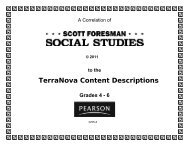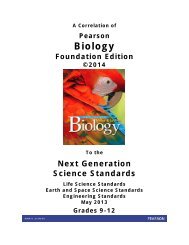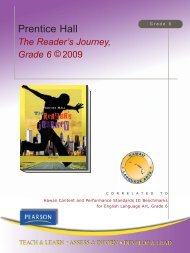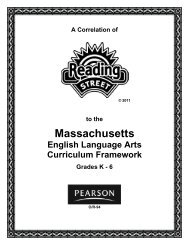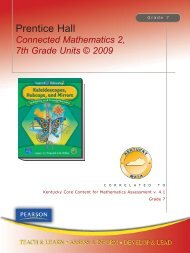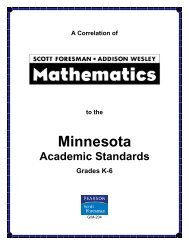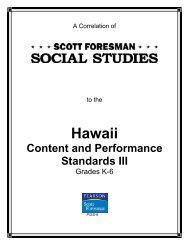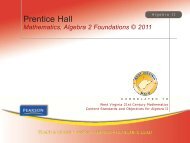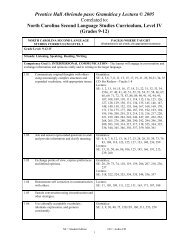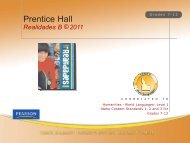Miller & Levine Biology - Pearson
Miller & Levine Biology - Pearson
Miller & Levine Biology - Pearson
Create successful ePaper yourself
Turn your PDF publications into a flip-book with our unique Google optimized e-Paper software.
A Correlation of<strong>Miller</strong> & <strong>Levine</strong> <strong>Biology</strong>, ©2014to the Next Generation Science Standards, May 2013Grades 9-12HS-LS1 From Molecules to Organisms: Structures and ProcessesHS-LS1 From Molecules to Organisms: Structures and ProcessesStudents who demonstrate understanding can:HS-LS1-1. Construct an explanation based on evidence for how the structure of DNA determines the structure of proteinswhich carry out the essential functions of life through systems of specialized cells. [Assessment Boundary: Assessment does not includeidentification of specific cell or tissue types, whole body systems, specific protein structures and functions, or the biochemistry of protein synthesis.]<strong>Miller</strong> & <strong>Levine</strong> <strong>Biology</strong>: Students are introduced to the structure of DNA in Lesson 12.2 (pp. 344–348) and to DNA replication in Lesson12.3 (pp. 350–352). Lessons 13.1 and 13.2 (pp. 362–371) provide evidence for how the structure of DNA determines the structure ofproteins.Students construct an explanation based on evidence about how the structure of DNA determines the structure of proteins: Studentsexplain how the unique structure of DNA makes the functions of DNA possible (Q2, p. 355). Students write a paragraph explaining thecentral dogma of molecular biology—information is transferred from DNA to RNA to protein (TE p. 371). Students explain the roles of thethree types of RNA in using the information stored in DNA to make proteins (Q38, p. 388).HS-LS1-2. Develop and use a model to illustrate the hierarchical organization of interacting systems that provide specificfunctions within multicellular organisms. [Clarification Statement: Emphasis is on functions at the organism system level such as nutrient uptake, water delivery,and organism movement in response to neural stimuli. An example of an interacting system could be an artery depending on the proper function of elastic tissue and smooth muscleto regulate and deliver the proper amount of blood within the circulatory system.] [Assessment Boundary: Assessment does not include interactions and functions at the molecular orchemical reaction level.]<strong>Miller</strong> & <strong>Levine</strong> <strong>Biology</strong>: Students are introduced to levels of organization in Lesson 7.4 (p. 216). Plant structure and function is addressedthroughout Chapter 23 (pp. 664–687). Lessons 27.1 (pp. 782–786), 27.2 (pp. 787–790), 27.4 (pp. 794–798), 28.2 (pp. 814–818), 28.3 (pp.819–826), and 28.4 (pp. 827–830) focus on the interacting systems in animals. The corresponding systems in humans are addressed inLessons 30.1 (pp. 862–867), 30.3 (pp. 875–881), 30.4 (pp. 882–887), 31.1 (pp. 896–900), 32.1 (pp. 922–927), 33.1 (pp. 948–953), 33.3(pp. 963–969), 34.1 (pp. 978–981), 34.2 (pp. 982–987), and 35.1 (pp. 1010–1013). 35.2, Immune System, pp. 1014-1019Representative examples of how students develop and use a model to illustrate the organization of systems that provide specific functions:Students draw a diagram of a cell membrane and use it to explain how the cell regulates what enters or leaves the cell (Q1 and Q2, p.219). Students make a model of a seed plant and explain how the model would change if the plant grew in a wet environment (Q1 and Q2,p. 689). Students draw a Venn diagram to relate the four levels of organization in the human body (Q3, p. 867). Students evaluate theusefulness of a swimming pool filter as a model for a nephron (Q1, p. 889).HS-LS1-3. Plan and conduct an investigation to provide evidence that feedback mechanisms maintain homeostasis. [ClarificationStatement: Examples of investigations could include heart rate response to exercise, stomate response to moisture and temperature, and root development in response to waterlevels.] [Assessment Boundary: Assessment does not include the cellular processes involved in the feedback mechanism.]MILLER & LEVINE BIOLOGY: The term homeostasis is defined in Lesson 1.3 (p. 19). Students learn how cells maintain homeostasis inLesson 7.4 (pp. 214–217) and the role that stomata play in maintaining homeostasis in plants in Lesson 23.4 (pp. 682–683). The termfeedback inhibition is defined in Lesson 25.1 (p. 732). Lesson 28.4 (pp. 827–830) explains why all body systems must work together.Mechanisms that control kidney function, gas exchange, and blood glucose levels are discussed in Lesson 30.4 (p. 886), Lesson 33.3 (pp.966–967), and Lesson 34.2 (p. 984), respectively.Students plan and conduct investigations that provide evidence about homeostasis and feedback mechanisms: Students examineleaves to determine the average number of stomata per square inch (Quick Lab, p. 683). Students develop a method for maintaining waterat a specific temperature for fifteen minutes (Quick Lab, p. 866). Students explore how plant hormones affect leaf loss (Lab Manual A, pp.147–150) and how chemicals affect heart rate in Daphnia (Lab Manual A, pp. 265–269).HS-LS1-4. Use a model to illustrate the role of cellular division (mitosis) and differentiation in producing and maintainingcomplex organisms. [Assessment Boundary: Assessment does not include specific gene control mechanisms or rote memorization of the steps of mitosis.]<strong>Miller</strong> & <strong>Levine</strong> <strong>Biology</strong>: The process of cell division is described in Lesson 10.2 (pp. 279–285). The process of cell differentiation isintroduced in Lesson 10.4 (pp. 292–297). In Lesson 13.4 (pp. 381–383), students learn that genes control the differentiation of cells incomplex organisms.Students use a model to illustrate their understanding of cellular division in complex organisms: Students use a Visual Summary of mitosisto explain the critical relationship between the breakdown of the nuclear envelope and the formation of the mitotic spindle (p. 285). Studentsdraw a model of the cell cycle for a eukaryotic cell; label key events that result in growth and cell division; and expand the model toinclude two additional rounds of cell division (Q1 and Q2, p. 299). Students with special needs use physical models of cells to feel anddescribe the structural differences between stem cells and differentiated cells (TE p. 295). Students compare the processes cells use toSE = Student Edition; TE = Teacher’s Edition; LMA = Lab Manual A 4



